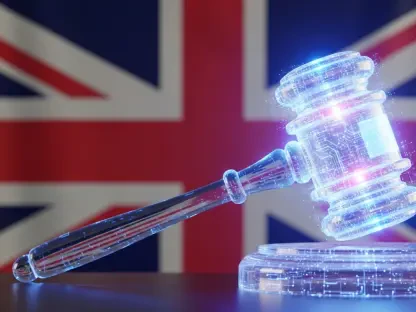In an increasingly complex regulatory landscape, the intersection of artificial intelligence and compliance presents unique challenges. Legal expert Desiree Sainthrope provides her insights on navigating these complexities, drawing on her extensive experience in global legal frameworks and the intricacies of AI adoption.
What are the main challenges companies face with regulatory compliance in the context of AI adoption?
Companies face a multitude of challenges when integrating AI into their operations, driven largely by the stringent regulatory requirements. Key among these are understanding evolving regulations, balancing compliance with innovation, and managing the inherent unpredictability of AI technologies. These factors require companies to stay diligent and adaptive in their compliance strategies while striving for technological advances.
How do the GDPR, Data Act, AI Act, and Cyber Resilience Act impact the regulatory burden on companies?
These acts collectively increase the regulatory burden by mandating stricter controls and procedures for data handling, AI application, and cyber resilience. Such requirements can substantially elevate compliance costs and complexity, pushing companies to reconsider their strategies and operations to meet the legal stipulations effectively without stalling innovation.
Can you explain why some companies might be slow in adopting AI technologies due to regulatory compliance issues?
The primary reason is uncertainty. Companies are hesitant to adopt AI technologies partly due to unclear guidelines on compliance—even involving potential missteps could result in severe penalties. This fear of repercussion can lead to a cautious approach, delaying the adoption of AI until clearer pathways are established by regulatory bodies.
What role does the difficulty of interpreting new rules, acts, and regulations play in AI adoption?
Interpreting new laws can be a daunting task and often leads to conflicting viewpoints. Companies may engage multiple legal advisors and receive varied interpretations, complicating decision-making. As they seek to avoid risk and ensure compliance, this ambiguity can stall AI-related initiatives, hindering their operational and competitive potential.
How do companies typically deal with differing interpretations of regulations, such as the case with the Data Act?
Most opt for conservative approaches, implementing strategies that ensure compliance even under multiple interpretations. This might involve over-compliance or scaling back certain operations to avoid potential breaches. Although costly, such approaches mitigate the risk of regulatory penalties while redefining business practices to align with varied legal viewpoints.
Why might companies opt to avoid innovations and maintain the status quo when dealing with compliance risks?
The financial and reputational risks associated with non-compliance can often outweigh the benefits of pioneering new technologies. Companies might suppress innovation to ensure stability and predictability, minimizing variables and avoiding scenarios that could lead to rule violations. This status quo bias can be pivotal in risk management.
How do companies decide to move innovation activities to regions with less strict rules and regulations?
This decision typically revolves around cost-benefit analyses of regulatory environments. Companies might compare legal constraints against the flexibility offered in different regions and opt to transfer certain operations or developmental activities to areas with less stringent regulations, thus maximizing their innovative capabilities while managing risks.
What are the regulations or acts that require a human in the loop for oversight, and why is this challenging for AI adoption?
Several regulations emphasize human oversight—requirements rooted in liability concerns and ethical standards. These can be challenging for AI due to the dynamic nature of technology and the scalability issues inherent in maintaining human checks. This demand for manual oversight can slow down automated processes, diluting the benefits of AI efficiencies.
How does the non-deterministic nature of machine learning pose challenges in compliance, especially in safety-critical contexts?
Machine learning’s unpredictable behavior complicates implementing fail-safes and compliance guarantees, particularly where safety is paramount. This unpredictability strains existing compliance frameworks, necessitating robust monitoring architectures and reliable fallback mechanisms to prevent adverse impacts and ensure operational integrity.
Could you discuss the limitations of algorithmic software and the importance of architectures that monitor and handle components failing to operate as expected?
Algorithmic software, while powerful, can deviate from expected behaviors due to code errors or environmental variations. Effective architectures must continuously assess performance, allowing businesses to pinpoint anomalies and initiate corrective actions. Such resilience aids compliance adherence and fortifies reliability across AI applications.
Why is there a significant lack of automation in proving regulatory compliance, and how does it affect companies’ operations?
The manual processes for evidence gathering—driven by the complexities and nuances of regulations—require substantial human resources, leading to inefficiencies. Despite technological advances, automation tools are rarely robust enough to meet compliance standards, complicating verification tasks and slowing down operational outputs.
How does the reliance on human labor for evidence collection influence the release of new technologies and products?
Relying heavily on human input for compliance checks inherently delays product releases, as it creates bottlenecks in the process chain. This reliance not only obstructs rapid deployment but can also lead companies to defer innovations, preferring to stick with known compliance pathways to reduce potential liabilities.
In your opinion, how can companies balance the need for regulatory compliance with the drive for innovation and AI adoption?
Achieving this balance requires strategic foresight and adaptive management, leveraging risk assessment alongside innovative practices. Companies should build interdisciplinary teams that merge legal expertise with technological insights, cultivating an environment responsive to continual regulatory changes while pushing forward with AI-driven initiatives.
Do you have any strategies or suggestions for companies seeking to navigate the heavy regulatory burden while implementing AI technologies?
Companies can benefit from proactive and continuous engagement with regulatory authorities, seeking guidance to understand compliance thresholds. Investing in robust compliance infrastructures and fostering collaborative dialogues with legal experts could help demystify regulations and enable informed, confident AI adoption strategies.
How do you interpret George Allan’s quote about valuing innovation and freedom over regulation in today’s technology landscape?
Allan’s quote underscores the broader tension between creativity and constraint within technological realms. While regulation is necessary for accountability and safety, excessive regulation can stifle growth. Companies should strive to foster an innovative spirit that balances freedom with responsibility, pushing the boundaries of technology while respecting legal frameworks.









